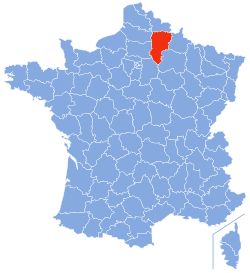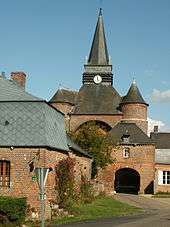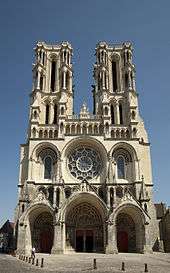Aisne
| Aisne | |||
|---|---|---|---|
| Department | |||
| |||
 Location of Aisne in France | |||
| Coordinates: 49°30′N 3°30′E / 49.500°N 3.500°ECoordinates: 49°30′N 3°30′E / 49.500°N 3.500°E | |||
| Country | France | ||
| Region | Hauts-de-France | ||
| Prefecture | Laon | ||
| Subprefectures |
Château-Thierry Saint-Quentin Soissons Vervins | ||
| Government | |||
| • President of the General Council | Yves Daudigny (PS) | ||
| Area1 | |||
| • Total | 7,369 km2 (2,845 sq mi) | ||
| Population (2013) | |||
| • Total | 540,067 | ||
| • Rank | 49th | ||
| • Density | 73/km2 (190/sq mi) | ||
| Time zone | CET (UTC+1) | ||
| • Summer (DST) | CEST (UTC+2) | ||
| Department number | 02 | ||
| Arrondissements | 5 | ||
| Cantons | 21 | ||
| Communes | 805 | ||
| ^1 French Land Register data, which exclude estuaries, and lakes, ponds, and glaciers larger than 1 km2 | |||
Aisne (French pronunciation: [ɛːn]) is a French department in the Hauts-de-France region of northern France. It is named after the river Aisne.
Geography
The department of Aisne is surrounded by the French departments of Nord, Somme, Oise, Ardennes, and Seine-et-Marne and borders Belgium to the northeast. The Aisne River crosses the area from east to west, where it joins the Oise River. The Marne forms part of the southern boundary of the department with the department of Seine-et-Marne. The southern part of the department is the geographical region known as la Brie poilleuse, a drier plateau known for its dairy products and Brie cheese.
According to the 2003 census, the forested area of the department was 123,392 hectares, or 16.6% for an average metropolitan area of 27.4%.[1]
The landscape is dominated by masses of rock which often have steep flanks. These rocks appear all over the region, but the most impressive examples are at Laon and the Chemin des Dames ridge.
The principal cities in Aisne are :
- Laon, pop. 26,000 (capital)
- Saint-Quentin, pop. 60,000
- Soissons, pop. 30,000
- Château-Thierry, pop. 15,000
- Tergnier, pop. 15,000
- Condren
- Chauny
- Hirson
- Villers-Cotterêts
- La Fère
- Vervins
- Guise
See also: List of the communes of the Aisne department and Brie.
Hydrography
The Scheldt (which takes its source near Le Catelet), the Aisne, the Marne, the Ourcq, the Vesle, the Somme (which rises in Fonsommes), the Oise, and the Serre. In the south of the department, there is the Surmelin, the Verdonnelle, and the Dhuys (this river is channeled into the Dhuis Aqueduct, 131 km long, to supply drinking water to Paris since 1 October 1865 and also more recently the Leisure Park of Marne-la-Vallée).
The department is also crossed by numerous canals (e.g. the Canal of Saint-Quentin, 93 km).
Railways
The county is crossed by three railway lines from Paris: the first two from the Gare du Nord and the third from the Gare de l'Est:
- the line from Paris to Maubeuge, serving cities including Chauny, Tergnier and Saint-Quentin
- the line from Paris to Laon, serving cities including Soissons, Anizy-le-Château, and Laon (prefecture)
- the line from Paris to Strasbourg, serving the city of Château-Thierry.
In 1873, the department of Aisne had 10 railway companies with a total length of 382 km.[2]
Climate
There is an average of 500 to 750 mm precipitation annually.
Weather Data for Saint Quentin - Roupy
| Climate data for Saint Quentin - Roupy from 1961 to 1990 | |||||||||||||
|---|---|---|---|---|---|---|---|---|---|---|---|---|---|
| Month | Jan | Feb | Mar | Apr | May | Jun | Jul | Aug | Sep | Oct | Nov | Dec | Year |
| Average high °C (°F) | 4.6 (40.3) |
6.3 (43.3) |
9.4 (48.9) |
13 (55) |
17 (63) |
20.1 (68.2) |
22.3 (72.1) |
22.3 (72.1) |
19.4 (66.9) |
14.7 (58.5) |
8.7 (47.7) |
5.6 (42.1) |
13.6 (56.5) |
| Daily mean °C (°F) | 2.3 (36.1) |
3.4 (38.1) |
5.8 (42.4) |
8.6 (47.5) |
12.3 (54.1) |
15.2 (59.4) |
17.1 (62.8) |
17.1 (62.8) |
14.6 (58.3) |
10.8 (51.4) |
5.9 (42.6) |
3.2 (37.8) |
9.7 (49.5) |
| Average low °C (°F) | 0 (32) |
0.4 (32.7) |
2.2 (36) |
4.2 (39.6) |
7.6 (45.7) |
10.3 (50.5) |
11.9 (53.4) |
11.8 (53.2) |
9.8 (49.6) |
7 (45) |
3 (37) |
0.9 (33.6) |
5.8 (42.4) |
| Average precipitation mm (inches) | 57.1 (2.248) |
47.5 (1.87) |
57.1 (2.248) |
50.2 (1.976) |
63 (2.48) |
66.2 (2.606) |
59.5 (2.343) |
51.6 (2.031) |
56.7 (2.232) |
59.1 (2.327) |
68.1 (2.681) |
61.1 (2.406) |
697.2 (27.449) |
| Source: Infoclimat: Saint Quentin - Roupy (1961-1990)[3] | |||||||||||||
History
Aisne is one of the original 83 departments created during the French Revolution on 4 March 1790. It was created from parts of the former provinces of Île-de-France (Laon, Soissons, Noyon,and Valois), Picardy (Thiérache Vermandois), and Champagne (Brie,and Omois).
Most of the old growth forests in the area were destroyed during battles in World War I. The French offensive against the Chemin des Dames in spring 1917 is sometimes referred to as the Second Battle of the Aisne.
Heraldry
 |
The Arms of Aisne combines the arms of the former Comté de Ponthieu at the top with those of the former Province of Champagne below. The wavy middle bar represents the river Aisne. This shield is a proposal by Robert Louis, and has as yet no official value.
The arms of the commune of Aisne are blazoned : Party per fess wavy argent, one of Or three bendlets of azure; two of azure with band argent between two cotices potent counter potent of Or and Azure. |
Economy
Agriculture dominates the economy, especially cereal crops. Beet sugar is one of the most important industrial crops of the area. Silk, cotton, and wool weaving flourish in Saint-Quentin and other towns. Saint-Gobain is known for its production of mirrors, which started in the 17th century. Guise is the agricultural centre of the northern area of Aisne.
Politics
The department is a mixture of rural areas and working-class towns. As a place of residence for some families working in Paris or Île-de-France, Aisne was for many years a department rather oriented to the left, with a majority on the General Council on the left since 1998, and the same for the majority of parliamentary seats representing the department in the National Assembly.
The smaller cities of the northern department such as Guise, Hirson, Vervins and the railway city of Tergnier are sources of support for left-wing parties.
The President of the General Council is the Socialist Yves Daudigny.
| Party | seats | |
|---|---|---|
| • | Socialist Party | 17 |
| • | Miscellaneous Left | 7 |
| Miscellaneous Right | 8 | |
| Union for a Popular Movement | 6 | |
| • | French Communist Party | 4 |
Administration
Aisne is divided into five arrondissements and 21 cantons. The department has 805 communes and five parliamentary constituencies.
Demography

The department of Aisne includes one medium-sized city (Saint-Quentin) and three small cities (Laon, Soissons and Château-Thierry) to which may be added the conglomeration formed by Chauny and Tergnier. There are many other agglomerations of an urban character because Aisne has been densely populated since before the 19th century. The villages are numerous and rather small.
Aisne lost some of its population in the second half of the 19th century, due to the rural exodus but this was limited by the industrial development in the north of the department (Saint-Quentin, Chaunois, Thiérache).
Greatly affected by the First World War, the department has seen its population grow slightly to the same level as in 1900. For thirty years, the industrial decline has caused stagnation of the population (526,346 in 1968, 535,489 in 1999). Only the south-west of the department, close to the Paris conurbation, has seen much population growth.
Tourism


The boat tours relates in part to the Canal de Saint-Quentin with its electric towage and two tunnels (Lesdins and Riqueval/Vendhuile).
In 2007, a large infrastructure for tourist accommodation, the Center Parcs, was built on the Lake of Ailette, close to many tourist attractions such as the Cathedral of Laon, the Chemin des Dames and the Château de Coucy.
Among the many places to explore are:
- Monuments
- Castle of Villers-Cotterets at Château-Thierry
- Château de Condé
- Château de Coucy
- Castle Oigny-en-Valois
- Dungeon of Septmonts
- Château of Guise
- Cathedrals
- Churches and abbeys
- Saint-Michel-en-Thiérache Abbey
- Abbaye du Tortoir de Saint Nicolas aux Bois
- Abbaye Saint-Vincent de Laon
- Abbaye Saint-Martin de Laon
- Longpont Abbey
- Abbey of St. Jean des Vignes
- Vauclair Abbey
- Church of Saint-Caprais
- Abbey church of Saint-Yved de Braine
- War memorials of the First World War
- Chemin des Dames
- The Caverne of the Dragon
- The Landowski Ghosts, Margival
- Bois de Belleau/Bois de la Brigade de Marine
- Musées
- Musée Henri Matisse à Bohain-en-Vermandois
- Quentin de Latour Museum in Saint-Quentin
- Musée du cheminot, the Familistère de Godin at Guise.
Culture
During World War I a number of significant architectural monuments were destroyed. Of the buildings that survived, the medieval churches in Laon, Braine, and Urcel are the most significant. The ruined castle of La Ferté-Milon escaped further damage during the war. Of the castles that survived, some were used as prisons, such as the Castle of Vadancourt, near Saint-Quentin (500 prisoners).[4]
It is thought that the Aisne River was the birthplace of the trench warfare seen in the First World War. The British Expeditionary Force (BEF) had initial early successes driving the Germans back to the Aisne River; the German troops dug in and managed to hold out against both British and French attacks. This German entrenchment was to mould the entire face of World War One as both sides began digging in and fortifying their positions. Thus began the stalemate that became a significant feature of the First World War.
Languages
- Picard in the north
- Champenois dialect in the south
- the French of Île-de-France in the centre and the south.
This linguistic variance probably explains the difficulty for residents south of Aisne to identify themselves as belonging to the Picardy region.
Gastronomy
- Rustic cuisine. The north of the department is a farming area and there are products made from cow's milk such as Maroilles cheese and Dulce de leche. There are also typically Picardy specialties such as "ficelle", a sort of rolled crêpe with cream cheese, béchamel, ham, and mushrooms. Foie gras is a product developed in Thiérache of the highest quality.
- The cultivation of red fruit (strawberries) is beginning to develop.
- Trade shows for: cheeses (La Capelle), blood sausage (Saint-Quentin).
- Tastings in flea markets and many opportunities to discover local products in a traditional atmosphere.
- In the south there are kidney beans form Soissons and the Tourist route of Champagne where some champagnes produced in the Chateau-Thierry region, like the maroilles, are recognized by the Appellation d'origine contrôlée (AOC).
- Thiérache cider and its eau-de-vie and the production of beer (mostly craft) give the department of Aisne real identity.
- Large swarms of bees mean that the flavours of honey, mead, gingerbread, vinegar etc. can be found.
Notable people linked to the department
- Achille Jacopin is a sculptor born in 1874 and died in 1958 at Château-Thierry
- Paul and Camille Claudel came from Tardenois
- Jean de la Fontaine was from Château-Thierry
- Alexandre Dumas was from Villers-Cotterets
- * The fictional character Jean Valjean was born in Faverolles, Aisne
- Jean Racine was from La Ferte-Milon
- Maurice Quentin de la Tour was born in Saint-Quentin
- François-Noël Babeuf, called Gracchus Babeuf (1760-1797) was from Saint Quentin
- Guillaume-Benoît Houdet, lawyer, MP, and Mayor of Château-Thierry (1800-1805)
- Henri Matisse, painter, spent his childhood in Bohain-en-Vermandois
- Sébastien Cauet, host-producer of television and radio French, is from Marle
- Jean-Baptiste André Godin (1817-1888), an industrialist and French philanthropist, creator of Familistère de Guise
- Nicolas de Condorcet (1743-1794), a philosopher, mathematician and political scientist was from Ribemont
- Leo Lemoine, mayor of Saulchery member of the Resistance in February 1941 and died for France in exile at Buchenwald Dora[5] with his son Jacques (17 years old)
- Kamini, a rapper, is from Le Nouvion-en-Thiérache
Second homes
In 2008, the department had 4.1% of second homes. This table shows the main communes of Aisne that have second homes which occasionally exceed 10% of total housing.[6]
| Town | Municipal Population | Number of Lodgings | Secondary Lodgings | %age Secondary Lodgings |
|---|---|---|---|---|
| Chamouille | 256 | 628 | 526 | 83.81 % |
| Neuville-sur-Ailette | 86 | 147 | 110 | 74.86 % |
| Berny-Rivière | 596 | 653 | 396 | 60.69 % |
| Ressons-le-Long | 762 | 393 | 90 | 22.90 % |
See also
- Cantons of the Aisne department
- Communes of the Aisne department
- Arrondissements of the Aisne department
References
- ↑ National Forestry Inventory: Départment of Aisne
- ↑ Geography of the department of Aisne (2nd edition), by Adolphe Joanne, 1874, p. 36
- ↑ Monthly Climate Archives - Saint Quentin - Roupy (1961-1990), consulted on 17 May 2013.
- ↑ Castle of Vadancourt (French)
- ↑ http://www.buchenwald-dora.fr/index.htm
- ↑ http://www.insee.fr/fr/recensement/page_accueil_rp.htm, INSEE, as at 1 January 2008.
External links
| Wikimedia Commons has media related to Aisne. |
- (French) Prefecture website
- (French) General Council website
- (English) Set up your business in Aisne
- (French) Chamber of Commerce and Industry of Aisne
- (French) Chamber of Trades of Aisne
- (French) Aisne Chamber of Agriculture
- (English) Aisne Development Agency
- (English) Official Tourist Board
- (French) Maps of Aisne
- Dmoz (French)
- Département de l’Aisne The Accounts of the Communes in fiscal groupings—Individual data for budget, consolidated data for the "Principle Budget and budget annexes"

